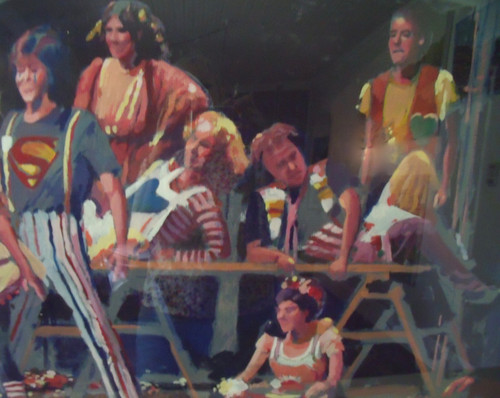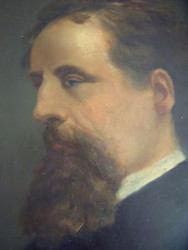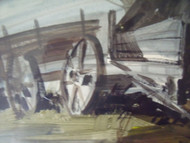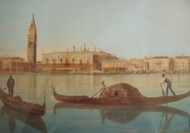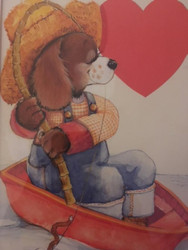Categories
Categories
- Home
- Illustration
- ORIGINAL GODSPELL ARTWORK : Set/Costume Design Painting Broadway Ca 1976
ORIGINAL GODSPELL ARTWORK : Set/Costume Design Painting Broadway Ca 1976
Product Description
Description: ORIGINAL GODSPELL ARTWORK : Set/Costume Design Painting Broadway Ca 1976
Dimensions: 39.5 X 23 Custom Framed; Under Plexiglass
Signature: No
Condition: Very good; slight water damage top and right corner see pics
Shipping $95.00
Note: This was sold to us as an original set design drawing from Godspell on Broadway from a member of the crew. It is not signed.
The Godspell Costume Story
In the fall of 1970, Carnegie Mellon University student Susan Tsu glanced at the drama department’s call board in the Fine Arts Building and found a listing for her name as costume designer for The Godspell. Tsu, a second year costume design major, reasoned that it must be a typo for Gospel, and thought, "Okay, it’s the New Testament. So gee, what do I do now?"
Before meeting with director John-Michael Tebelak, she imagined period costumes would be appropriate. But Tebelak had something completely different in mind.
He was finishing a master’s degree at CMU at the time, having just completed his undergraduate degree in directing there. For his thesis project he wanted to do something theatrical related to the Gospels. Then he attended an Easter Sunday church service that was so uninspiring that he was motivated to create a dramatic piece of a different order. As he told Dramatics Magazine: “I wanted to make it the simple, joyful message that I felt the first time I read [the Gospels] and recreate the sense of community, which I did not share when I went to that service.”
To bring the idea into focus, he latched onto ideas in Harvey Cox’s book The Feast of Fools. Cox saw clowns as promoters of joy. For Tebelak, associating Biblical material with clown-like performances helped ensure that the spirit of joy would pervade the piece. (See details about the concept and development of the show in The Godspell Experience.)
Godspell costumes wouldn’t, then, be anything related to the historical period that Jesus lived. Rather, he needed something that would work with the concept of clowns.
The Godspell Costume Story: Appendix D of The Godspell Experience. Copyright 2014 by Carol de Giere 2
Tebelak was twenty years old at the time and steeped in the values of the artistic young people around him on campus. Tsu knew of Tebelak, although he was a graduate student and she a “lowly sophomore” as she describes herself. “I much admired him. He had a wonderful imagination. And was tall and striking, with dark hair to his shoulders.”
It was an era when many students were disassociating themselves from older generations, and that often meant being a hippie or in some way being involved with the 1960s counterculture behavior and dress. Tsu remarks, “It was a very colorful period of time as far as what patterns and colors people were willing to wear. We were living in the middle of that.”
Tsu remembers that at their brief initial meeting, Tebelak said he wanted some combination of “hippies and clowns”—no more specifics than that.
Tebelak’s costume budget for the show was $150, which meant it would be a “pulled” show. The designer would go into the Carnegie drama department’s large collection of clothing and gather (pull) costumes that could be altered, or pieces of costumes that could be sewn together into new ones.
She headed for the vintage clothing collection in the College of Fine Arts building to find pieces for costumes for a cast of ten. Tsu sewed most of the new costumes herself, with last-minute help from her advisor for the final three pairs of pants.
After seeing David Haskell as Judas in rehearsal, she responded to his personality and performance. “He was like the ringmaster of the circus,” Tsu recalls, so she gave him a circus-suited tailcoat, and added things to it like stripes and military epaulettes. As for Jesus, she and Tebelak together came up with the idea of a Superman T-shirt that became the hallmark of Godspell.
The costumes gave the appearance of being almost spontaneously pieced together in the moment, and so they cohered with the
The Godspell Costume Story: Appendix D of The Godspell Experience. Copyright 2014 by Carol de Giere 3
improvisational flavor of the show. They were also childlike. Stephen Nathan, who played Jesus, comments about the musical: “Godspell was really all based on play, the innocence of children who see the world uncorrupted—that is how the whole piece evolved.” If the costumes had been slick and less playful, the look of the show would not have matched its spirit.
For their heads, the actors were given a hat, cap, or in Sonia Manzano’s case, a headband with giant feather plume sticking out of it. For their feet, the clowns wore colorful and varied shoes such as combat boots, high button shoes, and tennis shoes.
Tsu made Jesus and John/Judas distinct by using the boldest stripes (Jesus’ pants and Judas’ top coat) and having them go hatless.
These costumes essentially remained the same through the early days, from Carnegie Mellon University, to Café La MaMa to the early days at Cherry Lane.
Once the show became a hit, wardrobe supervisor Reet Pell took over the costume work, making new ones based on Tsu’s designs that were made of more durable fabrics so they could be regularly laundered. Pell worked for many years keeping all the actors in costume for multiple productions.
Courtesy: The Godspell Experience: Inside a Transformative Musical
A book by Carol de Giere with a Foreword by Stephen Schwartz
 Loading... Please wait...
Loading... Please wait... 
